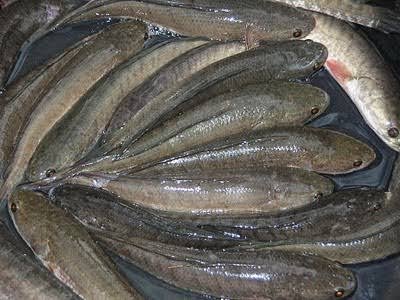the efficacy of cork fish
In areas that have waters, such as rivers, swamps, moats and lakes, there are still many fish that can be utilized as a source of protein. One of them is cork (Channa striata) which has been widely known by the people of Indonesia. These fish easily live in waters that have not been contaminated by pesticides. In nature cork fish are predatory fish, small fish predators, insects, child frogs (tadpoles), snails, worms and other types of aquatic animals.
This fish is widespread from South Asia, southern China to Southeast Asia, including western Indonesia. In Indonesia, many of the local names for this fish such as bocek (Riau), aruan, haruan (Malay), kocolan (Betawi), bogo (Sunda), bayong, bogo, licingan (Banyumas), cursing (Java), kabos (Minahasa) . In English known as common snakehead, snakehead murrel, chevron snakehead, striped snakehead and also aruan.
Adult cork fish can grow to a length of one meter. Big-headed rather spiky like a snake's head (so named snakehead), with large scales above the head. The round body is elongated with rounded fins at the ends. The upper side of the body from head to tail is dark, brownish or greenish, with the underside of a white body. The side of the crossed-up look like the surrounding environment. Big mouth with big and sharp teeth.
Fish cork has a kind of labyrinth organ (such as in catfish or betok), but more primitive resembling an amphibian respiratory system. This ability causes the cork to have adaptive ability to the environment that is moving or burying itself in the mud when the waters dry out. Often the cork fish 'walk' on the mainland, especially at night during the dry season, looking for another place that is still watery.
The cork and its relatives include Old World animals, namely from Asia (genus Channa) and Africa (genus Parachanna). In Indonesia there are several species of Channa. One of the close relatives of cork is the toman fish (Channa micropeltes), whose body length can exceed one meter and weigh more than 5kg.
Fish Corks and Health Benefits
Although other fish are also known as a good source of protein for the body, but fish cork is known to have a higher type of nutrient content. Protein content of cork fish was 25.5%, higher when compared with protein content of milkfish (20.0%), goldfish (16.0%), snapper (20.0%), and sardines (21 , 1%).
Remarkably, this cork fish is very rich in albumin, one of the important proteins for the human body. Albumin needed human body, especially in the healing process of wounds. The provision of fish cork meat or protein extract has been tried to increase levels of albumin in the blood and help cure some diseases such as cancer, stroke, kidney failure, diabetes mellitus until postoperative treatment.
Lack of albumin in the human body (hypoalbumin) causes the nutrients can not be circulated properly throughout the body. For children, lack of albumin will lead to inhibition of growth, brain development is not optimal, decreased immunity to cause the child easily sick.
In a study conducted prof. Nurpudji from Hasanuddin University, Makassar, giving 2 kg of cooked cork fish daily to postoperative patients will increase their albumin to normal. Provision of cork fish extract for 10-14 days showed an increase of albumin up to 0.6 to 0.8 g / dl. The content of albumin plus mineral zinc (Zn) in the cork fish body of 1.7412 mg / 100 g of meat is what helps the wound healing process faster.
Marinated for Economic Value
Actually cork fish has high economic value. Wild cork fish caught from rivers, lakes and swamps in Sumater and Kalimantapapan are marinated before being traded between islands. Salty is one of the dried fish is quite expensive. In addition, fresh cork fish, mostly sold alive, is an important source of protein for villagers, especially those close to swampy areas or rivers.
Fish cork is also a nice fishing fish. With live bait of insects or frogs, cork is relatively easy to fish. But his sharp teeth and strong tugs and tugs, can easily break the fishing line. For villagers who are particularly farmers, corks are very helpful in destroying pests, for example: rice paddies that are inhabited by snail pests, often end in harvest failures, as a result of the snails that often eat rice, especially at a young age.
However, these fish can also be very detrimental, ie when it goes to fish-keeping ponds. Cork is very greedy prey on small fish, so it can spend the fish that are kept in the pond, especially if the pet fish is still small. Reportedly, the introduced cork fish has grown into a disturbing species in Sulawesi and Papuakarena destroys native fish species.
...


Ku vote 2000 beh mangat ulak hahahaha
Hahaha